Hans van Rappard
2 ― From: Rappard, H. van (2009). Walking Two Roads- Accord and Separation In Chinese and Western Thought. Amsterdam: VU University Press. Chapter 1, pp. 28-43
part 1 – part 2 – part 3 – part 4 – part 5 – part 6 – part 7 – part 8 – part 9 – part 10 – part 11 – part 12 – part 13 – part 14 – part 15 – part 16 – part 17
Being in or beyond the world of ancient Greek thinking
The examples that have been presented are simple but they should have offered sufficient information to appreciate the following conclusions.
Recall that the point of departure of ancient Greek thinking is the world of the senses, notably vision. Therefore, in order to answer the question as to what a thing is, thinking has to proceed from the perceptions of a number of particular things to a general concept. This process is concluded by a definition, which states what the thing in question essentially is.
Thus, such a definition cannot but constitute a determination, that is, a delimitation of what the thing is and hence also of what it is not.
Knowing what a chair essentially is, always and under all circumstances, chairs may be clearly distinguished from stools. But this clarity comes at the price of invariability because definitions are not to be changed. Adding or subtracting a few features would make our carefully formulated definition useless because chairs might suddenly turn out not to be chairs anymore. Thus, as mentioned, the essential or ideal chair being a definition, it is nowhere to be found in the world of the senses but only in the world of thought.
A rational and a sensible world
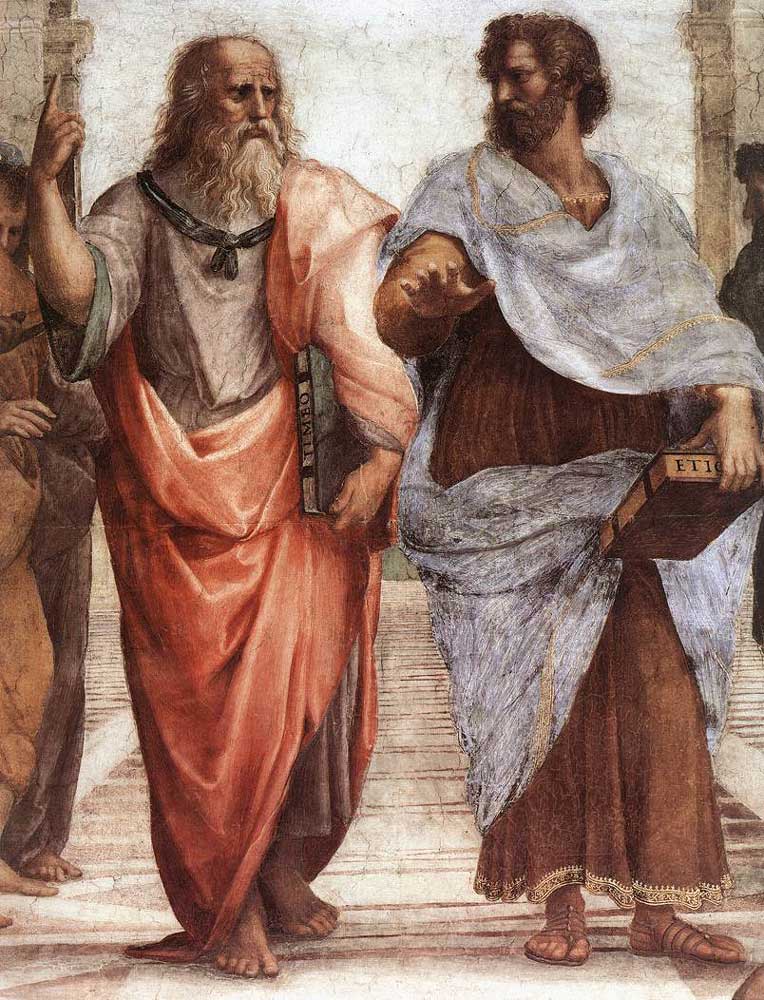
This brings us to a very important point because this view entails that a rift emerges between our everyday world and another world that is accessible only by means of thinking. Because the essences of perceptible things can only be found in thinking many ancient Greeks assumed that they formed part of another world ― a rational world separate from the sensible world.
In ancient Greece this world was called the world of being ― the true, ultimate reality of ideas (Plato) and the essences of things (Aristotle) were conceived as changeless and of the nature of being.
Our thought experiment was meant to demonstrate how the Greek thinkers could have arrived at the notion of a world of being. Significantly, the concept of being is absent in Chinese thinking and more than that, it would have been impossible for it to emerge. This will be treated below but at this point we will have to go a bit further into the notion of being in Greek philosophy.
Being and becoming
The problem of being and its relation to becoming or change was introduced by Parmenides (born ca. 514 BCE). According to Parmenides, the senses are inherently untrustworthy. They can only convey illusory opinions, such as the notion that things are subject to motion and change. But what Greek philosophers searched for is pure reality, which, they assumed, is complete, whole, and motionless. In a poem which has partially survived, Parmenides wrote
“What is, is; what is not, is not.”[2]
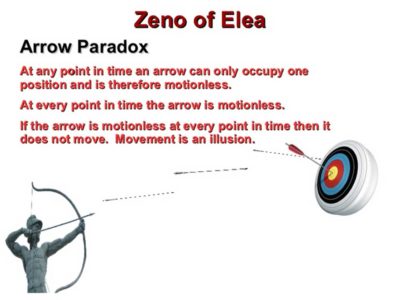
What he meant by this striking phrase is that change cannot but be illusory because that which is not cannot be, while that which is cannot cease to be. Hence, even the slightest change is impossible.
The possibility of motion was also attacked by Zeno of Elea (ca 490-430 BCE). In his paradox of the flying arrow Zeno argued that at any moment an arrow occupies a definite position, and since between two moments there is nothing but other moments the arrow can only occupy separate positions but never move from one position to another.
Plato and Aristotle
As a young man Plato (427-347 BCE) met a follower of Heraclites (d. 480 BCE) who persuaded him that all sensible things are in a continuous state of change and as such could be perceived but not known.
But this did not alter Plato’s conviction that it is only unchanging entities that can be the object of real knowledge. Thus, he had to look for permanent non-sensible objects which are accessible to the knowing mind. These were found in certain unchanging patterns behind the world of the senses, which Plato called ‘ideas’ or ‘forms’. Nothing, he felt, could be more real than ideal goodness, beauty, justice, and other such ideas, which constituted the unchanging structure of being. The ideas exist eternally,
“with a transcendent nature that sets them apart from our world.”[4]
But since according to Plato our world has been modelled after the ideas their essential qualities are diffused down into it, which, put metaphorically, allows ordinary humans to glimpse them as shadows on the wall of the cave they live in. The philosopher however, may after long training succeed in turning away from the shadows towards the light of real knowledge, which ultimately is the ‘idea of the good’. We will return to Plato in chapter three.
Concerning the problem of being versus change Plato’s star student, Aristotle (384-322 BCE) achieved something of a compromise. Whereas his mentor had maintained that the ideas or forms constitute being, Aristotle held that while the forms are indeed permanent, they manifest themselves in the world of changing things.
Take for example the statement ‘Felicity is a horse’, in which the predicate ‘horse’ is assigned to the subject ‘Felicity’. Now, according to Aristotle, Felicity’s horse-nature or ‘horsiness’ is a reality which does not exist apart from the countless horses actually embodying it. But whereas horses can be perceived, horsiness cannot ― just like Plato’s ideas it can only be thought. Aristotle called it essence and in his philosophy essence amounts to being.
The story of being of ancient Chinese thinking
We now turn to the Chinese story of being, if only to explain why there happens to be no such story. In this regard it must be mentioned first that in Aristotle the problem of being is linked to the structure of language, which comes down to the subject-predicate structure.
The structure of language and the structure of reality
Further, since the structure of language and the structure of reality were thought to be similar the world might, broadly speaking, also be understood along the lines of this structure. Putting two and two together this means that,
“The treatment of ‘being’ as a subject-matter is based on the subject-predicate formula of ancient Greek grammar [whose]structure is common to the Indo-European language families within which Western philosophy develops.”[5]
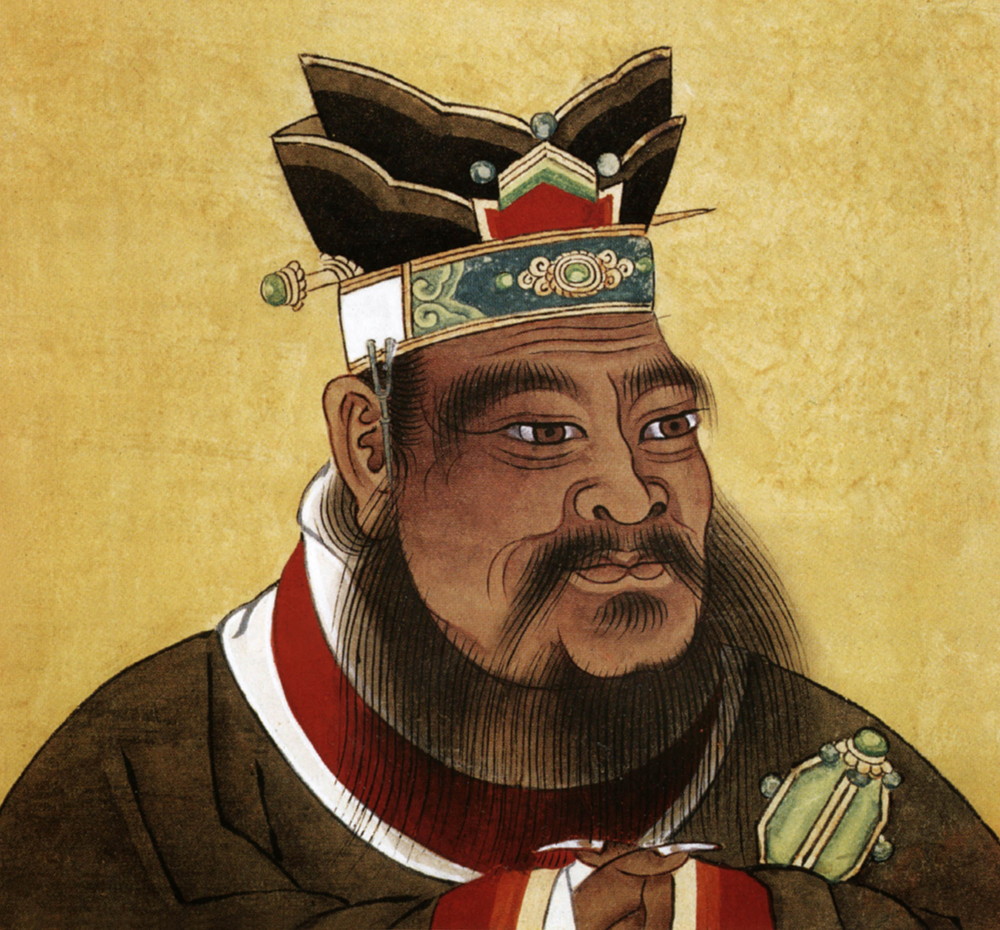
The Chinese however, never tried to derive a picture of the world from the structure of their language because language was not at all considered a reliable means to approach reality.
Laozi and Zhuangzi
The writings of Laozi and Zhuangzi abound with examples of their sceptical attitude towards language and, though less spectacular, Confucius too fits into this picture.
To approach the question of being in China it must also be mentioned that in English and other major Western languages the verb ‘to be’ is both copulative and existential.
Thus, it can be used to couple subject and predicate as in ‘the horse is white’ but also to say ‘there is a horse’.
The meaning of shi
The approximate Chinese equivalent of to be is shi. However, shi was not yet known as a copula during the golden age of Chinese philosophy and after its introduction it did not have an important role. Even today a copula is often not needed in Chinese and ‘horse white’ is sufficient.
More importantly, it would not have been possible for shi to prompt a notion of being because, whereas its Greek or English equivalents can function as a noun this is not the case in Chinese.
Thus, it does not make sense to ask ‘what is being?’ in Chinese. Shi cannot be used in the existential sense, that is, it cannot be used in the sense of ‘something that exists’.
What is more, even if this had been possible shi could still not have assumed the meaning of being in the Greek sense because the existential verbs that do exist in Chinese, you (yu) and wu (there is/ is not) are used only of concrete things but not abstract ideas,
“It is therefore not surprising that Chinese philosophy never raises the question of being, for the language upon which it is based does not provide it with relevant materials.”[7]
The concept of i

The significance of the Greek separation of being and change, which gave rise to the dual-world view that was totally alien to the Chinese, may be illustrated by a brief excursion to the concept of symbol, understood as a word used to represent something possessing different and wider connotations than the object that it usually refers to.
For instance, in Western culture the word rose may be used to symbolize love. The Greek word for symbol, which literally means ‘to take together’ is analogous to the word induction, which refers to the process of reasoning from the particular to the general by ‘taking together’ many observations.
It is worthy of note that a symbol (rose) represents something (love) that may be entirely unrelated to it. The word rose is completely different from and does in no way imply love. In other words, it normally represents a certain kind of flower but when used symbolically ‘rose’ carries a quite different meaning, which is based on a cultural convention.
Now, it is probably because of the loose connection between a symbol and what it stands for that symbols tend to be given a very wide scope by having them represent abstract ideas, such as a blind folded woman holding sword and scales who symbolizes Justice.
Thus, in the notion of symbol yet another instance is found of the rift between the world of daily life in which roses or scales and swords are, or at least were common place on the one hand, and the transcendent world of the ideas of love and justice on the other.
Jullien observes that Chinese literature has never privileged symbolism,
“It is not symbolic because it has nothing else to represent (that is, on another plane, such as the intelligible or essences).”[8]
Chinese science
Thinking in ancient Greece oscillated between two worlds and this feature was not shed in the centuries that followed, not even since the emergence of modern science in the sixteenth century. Small wonder then, that traditional Chinese science was different.
Its basic ideas can be appreciated on the basis of the ‘theory of the five elements’ (wuxing), the ‘two fundamental forces’ (yin and yang), and the Book of Changes (Yijing).
Theory of the five phases (wuxing)
The theory of what Needham called the five ‘elements’ but most later authors the five ‘phases’ (earth, wood, metal, fire, and water) was probably developed around the fifth century BCE and finalised during the Han dynasty (202 BCE-220 CE).
The theory was also extended to society, teaching that every ruling house reigned by virtue of one of the five elements. Thus, as a theory of the rise and fall of dynasties it dealt with the human world in basically the same way as the natural world.
All changes in human history were understood as manifestations of the same changes as those observable at the lower levels of reality and in both cases the ruling mechanism consisted of a uniform pattern of relations and reactions, which came to be known as the mutual or cyclical conquest.
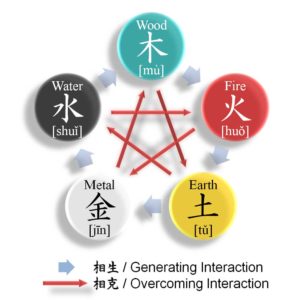
The mutual conquest order described the order in which each element was thought to conquer its predecessor.
For instance, wood conquers earth because in the form of a spade it can dig up (conquer) earth. But metal conquers wood since it can cut it, while metal in its turn is conquered by fire that melts it but which itself is conquered by water, while water is conquered by earth in the form of earthen dams, which completes the cycle.
Clearly, the cycle is based on the everyday observations of an agricultural society.
For instance, water is described as ‘soaking and descending’, fire as ‘blazing and uprising’, wood as permitting of ‘curved surfaces or straight edges’, metal as able to ‘follow [the form of a mould]and then become hard’, and earth as that which ‘permits of sowing, [growth]and reaping’.
It is worthy of note that these descriptions demonstrate that the elements were not so much conceived of as various kinds of matter as of processes,
“the Five-Element theory was an attempt to classify the basic properties of material things, properties, that is, which would only be manifest when they were undergoing change. The ‘elements’ were, in fact, five powerful forces in ever-flowing cyclical motion, not passive motionless fundamental substances [as in ancient Greece].”[10]
In the course of time the five elements got connected to virtually every category of things that allowed classification in fives: tastes, smells, colours, musical notes, yin-yang relations, planets, weather, states, rulers, styles of government, body parts, viscera, sense organs, emotional states, and many more.
For instance, in China space was divided in five regions: south, north, east, west, and centre, each of which was connected with one of the seasons (the days needed to complete the lunar year also making up a small season) and the five elements into so-called correspondences.
The east was connected with spring and wood, the south with summer and fire, etc. For the ancient Chinese things were organically connected rather than mechanically caused.
Yin and yang
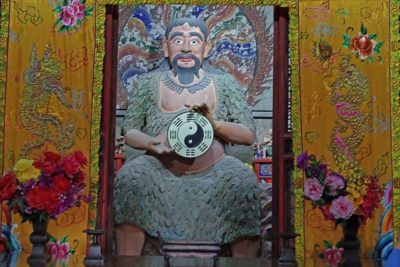
The theory of the two fundamental forces, yin and yang, dates from about the same time as the five elements. The Chinese character for yin denotes the shady side of a hill and is connected with darkness, cold, cloud and rain, and femininity. Yang is the opposite of yin; it refers to the sunny side of a hill and is connected with light and brightness, sunshine and warmth, spring and summer, and masculinity.
Generally speaking, yin and yang figure in the classical Chinese writings as the only two fundamental forces in the universe, now one dominating, then the other. In books dating from four or five centuries before our era it is stated that every living creature partakes of the nature of heaven and earth and the harmony of yin and yang.
Book of Changes (Yijing)
The yin and yang found a well known and currently still popular application in the third century BCE Book of changes (Yijing). They are represented by undivided (yang) and divided (yin) lines, which in eight three-line arrangements or trigrams yield sixty-four six- line hexagrams.
The heaven and earth trigrams, consisting entirely of undivided and divided lines respectively, are the pre-eminent symbols of the yang and yin, while the remaining six trigrams are thought to have come into existence by their intercourse. ‘Heaven’ and ‘earth’ are therefore called father and mother, the other trigrams sons and daughters. Moreover, everything or as the Chinese say, the ten thousand things are also thought to be generated by heaven and earth. Thus, one of the Appendices of the Yijing (below) says,
“The great characteristic of Heaven and Earth is to produce.”[11]
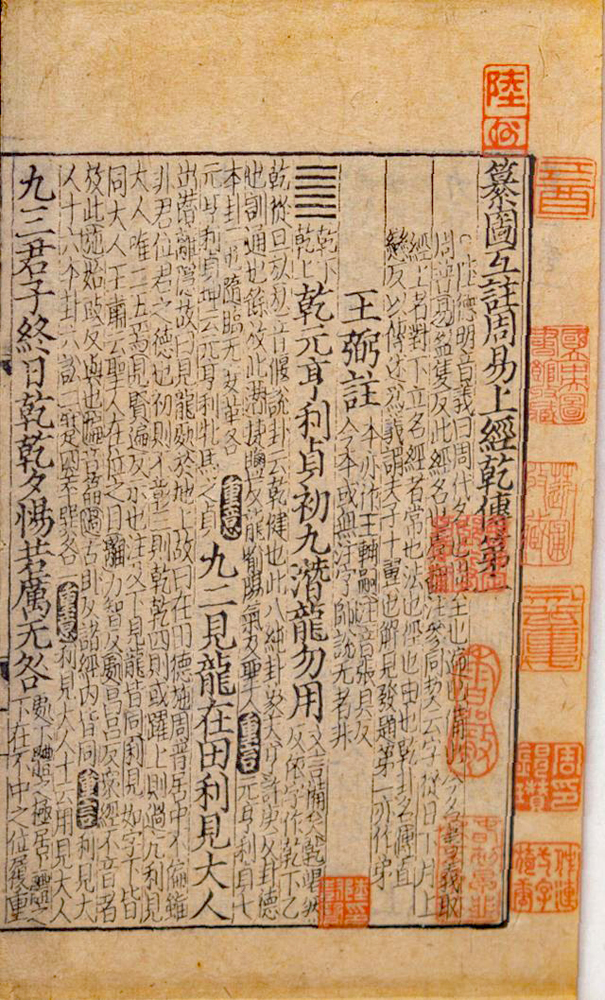
Little is known about the origins of the Yijing but its earliest parts, which may well constitute the oldest book in existence, were probably derived from divination practices. Initially there were two mainstreams of divination, one stressing the five elements, the other the yin and yang but although the elements have at one point been linked to the two forces, eventually it were the latter that became primarily connected to the Yijing.
It is assumed that the trigrams and hexagrams featuring in the Yijing were invented as early as the Zhou dynasty (1000-221 BCE) or even by the probably mythical first ruler of China, Fu Xi, as imitations of the cracks formed on tortoise shells’ or bones when heated for the purpose of divination.
The procedure included an interpretation of these cracks but since these might assume an almost endless variety of forms it was well-nigh impossible to divine according to preconceived formulas. Therefore, the divination procedure was supplemented with a method using milfoil stalks, which were shuffled in a particular way to get combinations yielding odd and even numbers.
The odd divided, and the even undivided lines of the trigrams may have come into existence as parts of the graphic representations of these combinations. In contradistinction to the shell cracks the possible number of combinations was limited, which allowed the use of interpretation formulas. Using this method the diviners could more easily obtain a set of lines and after consultation of the appropriate commentaries answer the question they had been asked.
Sixty-four hexagrams
As mentioned, the Yijing consists of sixty-four hexagrams. Connected to each hexagram there are explanations of the entire hexagram and of the component lines.
There are also seven commentaries, such as commentaries on the explanations, on the order of hexagrams, on certain trigrams, appended remarks, and others. Since some of these commentaries come in two parts there are ten so-called Appendices or Wings.
Although the Yijing began its career as a divination book, since the early Han dynasty it has primarily functioned as a philosophical treatise, which, from the Song (Sung) dynasty (960-1278) on, was destined to have a hard-to-overrate role in the development of Chinese philosophy. A crucial contribution of the Yijing is found in what its name so clearly conveys: change!
The cosmic yin and yang which are continuously engaged in producing the ten-thousand things are dynamic but not relative. As the third Wing says,
“One Yang and one Yin, this is the Tao.”[13]
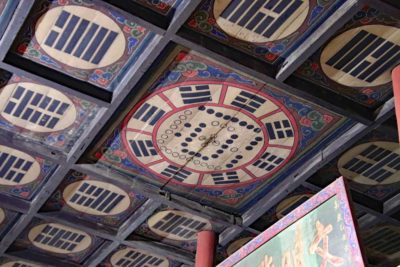
But viewed from a more mundane perspective yin and yang appear in a different light in which what is yin in one respect may be yang in another. For instance, a man is yang in relation to his wife but yin in relation to his father, while an old man may be yang in relation to a young one in terms of political power but yin in respect of stamina. Yin and yang are thus not fixed but depend on the relationship that is expressed.
This means, incidentally, that in spite of certain similarities between the Chinese and Greek polar systems (such as the one designed by Pythagoras) a fundamental difference is that yin and yang are not fixed entities.[14]
The Yijing however, took ‘change’ a step further than the initial yin/yang system since the cosmos emerges from it as dynamic through and through.
In the Appended remarks one reads,
“The successive movement of yin and yang constitutes the Way (Dao). What issues from the Way is good, and that which realizes it is the individual nature. The man of humanity (jen) sees it and calls it humanity. The man of wisdom sees it and calls it wisdom. And the common people act according to it daily without knowing it. In this way the Way of the superior man is fully realized … How perfect is its eminent virtue and great achievement! Its achievement is great because it possesses everything, and its virtue is abundant because it renovates things every day.”[15]
The interaction of yin and yang brings about a progressive development. In the beginning there is the ‘great ultimate’ (taiji), which is also called dao, or unity of yin and yang.
Eight trigrams
As described in the Appended remarks this is the source of ‘the great business of life’,
“… in the system of Change there is the Great Ultimate. It generates the Two Modes (yin and yang). The Two Modes generate the Four Forms (major and minor yin and yang). The Four Forms generate the Eight Trigrams.
The Eight Trigrams determine good and evil fortunes. And good and evil fortunes produce the great business [of life]….”[16]
Concerning this text translator Chan points out that although ‘form’ evidently refers to the major and minor yin and yang the word also denotes pattern and idea. This means that the interaction of the ‘two modes’, the cosmic yin and yang also brings forth the human world of thought and culture.
But this, Chan says, entails an entirely new interpretation of the ancient trigrams. Their yin and yang lines are no longer seen as just indicative of good and evil fortune but have now been blown up to cosmic forces, which allowed to take them as representing all possible forms of change. Conceived thus, the Yijing enabled the Chinese to understand their civilisation as an uninterrupted process of evolution, which can be traced to its simplest beginning. Instead of a universe
“controlled by spiritual beings whose pleasures can only be discovered through divination, we have a natural operation of forces which can be determined and predicted objectively.”[17]
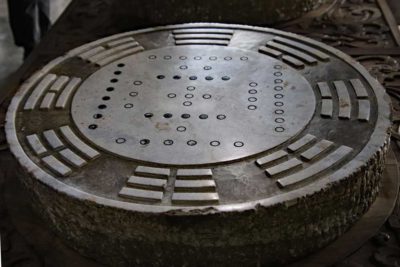
The trigrams were linked to elements, directions, numbers, and so on in a similar fashion as the five elements were linked to almost everything else. Josef Needham has likened the Yijing to a ‘giant filing system’ fitting in marvellously with the Chinese bureaucratic social order.[18]
But even if natural philosophy and science interacted closely with the social and political circumstances prevailing in China[19], this is as funny as it is unfair. Needham does no justice to the Yijing. It is probably a bit thick to call the Chinese philosophical tradition a collection of footnotes to the Yijing, analogous to Whitehead’s remark that the history of Western philosophy is a collection of footnotes to Plato but it would be difficult to overrate its significance for Chinese thinking.
In one particular version of the Lunyu Confucius says that if he had been granted more time to study the Book of changes he might have been “free from great errors”[20], while the texts found in the village of Mawangdui suggest that the elderly Confucius did actually study it.[21]
Moreover, the book was deemed important enough by his followers to ascribe the Appendices to him, while it also had an important role in later developments of Confucianism.
Furthermore, the Yijing was significant too for Daoism and indeed, it contains many congenial views. It may therefore be not too farfetched to call the Yijing the “proto-philosophy in the Chinese history of philosophy.”[22]
Complementarity
To an important extent, the proto-philosophical nature of the Yijing hinges on one specific point: its view of the relation between yin and yang. What is characteristic of this relation is that both opposites are not conceived of as separate and isolated from each other but as related in a complementary way.
That is, the relation between the two concepts is a dynamic unity-of-opposites ― a unity that would not be possible if the opposites were not complementary and if the unity were not dynamic. When yang comes, yin goes, and vice versa or, as is said in chapter forty of the Daodejing, “Reversal is the movement of Dao.”
The Appended remarks says,
“After the sun goes, the moon comes. After the moon goes, the sun comes. The sun and the moon push each other in their course and thus light appears. After the winter goes, the summer comes. After the summer goes, the winter comes. The winter and the summer push each other and thus the year is completed. To go means to contract and to come means to expand. Contraction and expansion act on each other and thus advantages are produced. The looper caterpillar coils itself up (contracts) in order to stretch out (expand). Dragons and snakes hibernate (contract) in order to preserve life (expand).”[23]
What is meant by their complementarity?
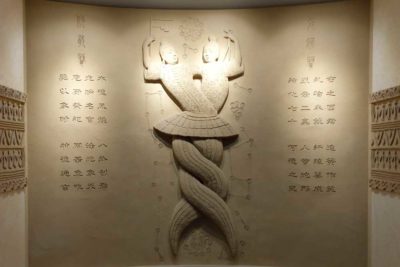
Thus, when yang comes, yin goes, and when yin comes, yang goes. But what is meant by their complementarity? To complement something entails that something is added to it in order to make it complete. This raises the question of what it is that was lacking and had to be added in order for it to be complete.
Recall that we are dealing with complementary opposites. Yin and yang are of course the prime example of opposites but at this point they might be a little too abstract to elaborate the significance of their complementary nature.
Let’s therefore take some of the many meanings ascribed to them for our starting point. Yin means the shady side of a hill and hence dark, plus a lot of other qualities that in the Chinese experience are related to dark, such as, rest, softness, femininity, simplicity, wisdom, and others.
On the other hand, yang, referring to the sunny hill side means light and is related to movement, firmness, masculinity, easiness, benevolence, etc. Thus, light may refer to the conditions of life, activity, and growth, and darkness to the conditions of death, rest, and decline.
To the Chinese mind all these meanings form pairs of opposites, even if this is perhaps not immediately evident in the case of simplicity and easiness. But to take a more obvious example, how could light and dark complement each other ― what completeness could their unity be, so to speak?
This completeness may be likened to a continuum. For instance, in the case of the light-dark polarity neither of these opposites will ever completely cover the continuum by itself. Absolute lightness or darkness do not exist in human life.
As pictured by the yin/yang symbol, there is always some darkness in the light, and light in the dark. When one of them is taken by itself their continuum is but partially covered. This happens when for instance, light is craved for and darkness is rejected. But the continuum is fully covered and hence complete when dark is ‘added’ to light, which may be achieved by accepting darkness as the inevitable counterpart of light.
There can be no light without dark, and no dark without light
A further reason why the continuum metaphor would seem to fit in with human experience is that our direct perception of light and dark and other polarities defies exact description. In the experience of everyday life light and dark are ambiguous; they are not absolutely positive nor absolutely negative. After all, light can be too harsh so that a little darkness or shade may be called for. Indeed, both are needed in human life.
This demonstrates that light and dark do not constitute absolute qualities, that is, qualities that can exist on their own, separated from each another. They are inherently related in that there can be no light without dark, and no dark without light.
Yet another reason why they cannot be considered absolute qualities is that they are dynamic: light is continuously alternating with darkness, and darkness with light. But this would not be possible if light were absolute, that is, if it did not possess a little dark, and dark a little bit of light. Indeed, everyday experience, understood
“not only as the alternation of day and night but as a juxtaposition of sunshine and tree shade, enables us to see light and shade, yin and yang as forming a unity of complementary opposites.”[24]
Dualities versus polarities
But less obvious examples than yin and yang in the experience of the Chinese may also be derived from day to day life in the West. After all, what would a teacher be without students and students without a teacher, what would capital be able to achieve without labour and vice versa, what would responsibility mean without freedom and the other way round?
Complementarity, therefore, also holds for thought and language, riddled as they are with dualities. Just consider, is it possible to conceive of objects as particular things, be they abstract or concrete, without discriminating them as either quick or slow, left or right, dated or up-to-date …?
Take a dictionary and pick adjectives at random; then look for their opposites. One is certain to succeed or, put differently, one will prove unable to find a single adjective lacking an opposite one. Against, say, high one finds low; against beautiful, ugly; good matches evil; as white does black; and so on, and so forth.
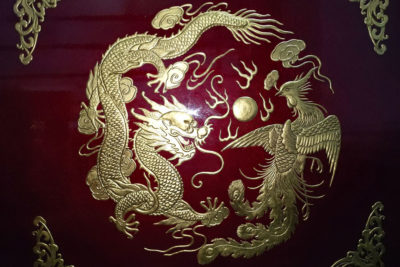
Many nouns too come in pairs: heaven & earth, man & nature, body & mind, life & death, night & day, roots & branches, buyer & seller, and many more could be mentioned.
Less salient perhaps but not less important is that the same goes for many verbs.
For instance, having something, we are afraid of losing it; when going somewhere, eventually we will have to stop; we like or dislike things, desiring or rejecting them; and when thinking, feeling is easily overlooked. Now, what this means is that language is simply shot through with opposites. This is no different in the East than in the West. In both corners of the world mountains are high and valleys are low but apparently, dual qualifications and pairs of opposites allow of different handling.
One option, cherished in Western thinking is to take opposites as dualities, such as good versus evil or labour versus capital. The Westerner keeps opposites apart, preferring and, as history teaches, often fighting one in favour of the other.
But the Chinese understand opposites as polarities ― polarities that mutually need each other. As summarised by Graham,
“in contrasting A with B the west tends to see them as conflicting, China as complementary.”[25]
Indeed, as yet no Chinese politician has used the expression ‘axis of evil’.
Teleological versus interdependent
We return to the worldview of the ancient and not quite so ancient Chinese. In what has emerged from the five elements, the two forces, and the Yijing, the key words are order and pattern, and above all, Needham concluded, organism.[26]
However, although organism would indeed seem to be an adequate term to characterise the Chinese view of the world this ancient but still current Western concept appears to carry a few unfortunate connotations.
The first is that it carries more or less holistic implications. Talking about organisms entails that the relevant phenomena are kept in line as it were, by a first principle, a deity, or another kind of ruler.
But in the Chinese view, the cosmic processes need not be kept in line because they are self-governing. Even if they are interdependent they happen entirely on their own account. They are ‘of themselves so’, which is the literal translation of ziran, the Chinese word for nature. Therefore, the notion of an external, not to mention transcendental ruler to whom the natural order can ultimately be traced has never occurred to the Chinese.
Secondly, since the Chinese cosmos does not constitute a holistic system governed by an external principle but, as observed in chapter twenty-five of the Daodejing ‘just follows its own inherent laws’.
It simply exists, and always has and always will exist ― but not as the cosmos of the ancient Greeks bounded by an ultimate goal towards which it relentlessly progresses.
The Greek view is teleological (telos means end, goal). Whereas the Greeks teleologically concluded that acorns become oak trees, in the Chinese tradition it is quite reasonable to conclude that most acorns become squirrels, as Ames wittily observed.
The absence of a fixed end and hence also the lack of a progressive development towards this end would seem to allow more degrees of freedom to the natural processes than would be possible in a cosmos conceived along organismic lines. Indeed, the reason why teleological views do not sit well with Chinese thinking, Ames explains,
“is that it introduces a goal that ‘instrumentalizes’ the process … it is the degree to which [the Chinese view]is free of any definite and specified goals, that gives it its flexibility and creative range.”[27]
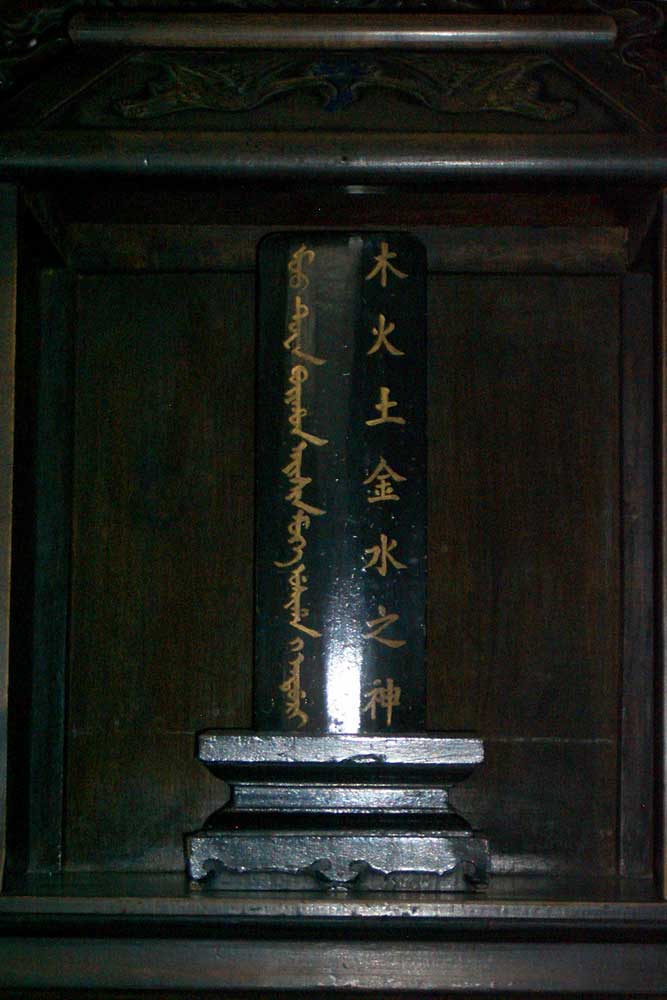
If things and processes behave in a particular way this is not caused by actions of other things and processes, which would entail the mechanistic causality that became predominant in Western science but by their position in an ever-changing universe and their intrinsic natures, which makes such behaviour natural for them.
Indeed, should they behave differently they would lose their positions in the cosmos, which would not simply change their relations to each other but, more fundamental, transform them into something different. Things and processes depend for their existence on the web of interrelations in its entirety and they react to each other by a kind of resonance.
Needham quotes a text dating from the second century BCE in which this is illustrated.
“All things reject what is different (to themselves) and follow what is akin … if notes correspond, they resonate. The experimental proof of this is extraordinarily clear. Try tuning musical instruments. The kung note or the shang note struck upon one lute will be answered by the kung or the shang notes from other stringed instruments. They sound by themselves. This is nothing miraculous but the Five Notes being in relation.”[29]
The Chinese view of causation was fairly sophisticated. On the one hand, the Chinese did not take the primitive view that anything could randomly cause anything else. After all, the correspondences have selective effects.
But on the other hand, nothing was uncaused either although this did not entail that things were ruled by immutable laws as posited by the natural sciences. Rather, the regular pattern of the natural processes was understood along the lines of the mutual adaptations required by community life. This means that here again a parallel is found between the social and the natural world.
“Not in human society only, but throughout the world of Nature, there was a give and take, a kind of mutual courtesy rather than strife among inanimate powers and processes.”[30]
The different ways of thinking in ancient Greece and China
Let us pause for a moment and note what has so far been learned about the different ways of thinking that emerged in ancient Greece and China. What was said about Greek scientific thought should suffice to demonstrate an overall dualistic way of thinking.
With regard to the Chinese we should be capable of perceiving a way of thinking characterised by words like order, pattern, relation, and mutuality, while we should also be able to appreciate that in Chinese thinking there is not a shred of dualism to be found.
Indeed, we have not come across the merest hint at the existence of a separate world of unchangeable essences or ideas.
However, quite fittingly in view of the metaphors of mist and breeze that to some extent characterise Chinese thinking, what we have come across are precisely hints and nothing more, that is, nothing that is more specific.
Indeed, attempting a pun on the title of a book written many years ago by Alan Watts, Chinese thinking might be characterised as ‘the wisdom of unspecificity’.[31]
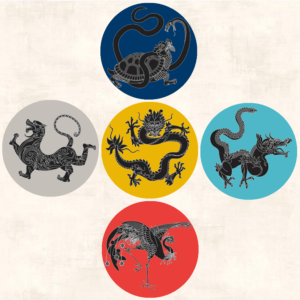
The correlational way of thinking as it is called by many authors or better perhaps, the co-relational way of thinking that proved typical of China is easily contrasted with thinking in the Greece of antiquity because the latter stressed fixed, unchanging, and well-defined concepts of separate, individual things.
The theory of the five ‘elements’ however, did not refer to matter but to processes. Significantly, the Chinese word xing (in wu xing or five elements) actually means to walk, do, act, travel ― all verbs referring to action and movement. Thus, it is nowadays translated as ‘phase’.
Concepts of mechanical cause and effect versus terms of patterns
Although we have so far only touched on the difference between the worldviews and their accompanying frameworks of thought in ancient China and Greece, a bare outline will now be perceptible.
Whereas Greek thinking developed concepts of mechanical cause and effect, the Chinese thought in terms of patterns. But this should not be understood as a sign of backwardness because the Chinese universe too was a well-ordered one. It was not governed though by a first mover or a creator but by a natural harmony.
“Universal harmony comes about not by the celestial fiat of some King of Kings, but by the spontaneous cooperation of all beings in the universe brought about by their following the internal necessities of their own natures.”[33]
If the moon waxes and wanes at certain times this is not because it follows a law but because it is in the nature of the cosmic pattern,
“… the conception of a net is close to that of a vast pattern. There is a web of relationships throughout the universe, the nodes of which are things and events. Nobody wove it, but if you interfere with its texture, you do so at your peril.”[34]
- Ames, R.T. (1994). The focus-field self in classical Confucianism. In R. Ames, W. Dissanayake, and T.P. Kasulis (Eds.). Self as person in Asian theory and practice (pp. 187-212). Albany: SUNY Press.
- Chan, Wing-tsit. (1963). A sourcebook in Chinese philosophy. Princeton: Princeton U.P.
- Cheng, Chung-ying. (1989). Chinese metaphysics as non-metaphysics: Confucian and Daoist insights into the nature of reality. In R. E. Allinson (Ed.). Understanding the Chinese mind (pp. 167-208). Oxford: Oxford U.P.
- Cheng, Chung-ying. (2003a). Philosophy of change. In A.S. Cua (Ed.). Encyclopedia of Chinese philosophy (pp. 517-524). New York:
- Cheng, Chung-ying. (2003b). Ti: body or embodiment. In A.S. Cua (Ed.). Encyclopedia of Chinese philosophy (pp. 717-720). New York:
- Fung, Yu-lan. (1960). A short history of Chinese philosophy. New York: Macmillan
- Fung, Yu-lan. (Transi). (1931/1995). A Taoist classic: Chuang-tzu. A new selected translation with an exposition of the philosophy of Kuo Hsiang. Beijing: Foreign Languages Press.
- Jullien, F. (2000). Detour and access: Strategies of meaning in China and Greece (Sophie Hawkes, transl.). New York: Zone Books.
- Kuriyama, S. (1999). The expressiveness of the body and the divergence of Greek and Chinese medicine. New York: Zone Books.
- LinYu-tang. (1967). The Chinese theory of art. London: Heinemann
- Liu Dan Zhai. (1996). Paintings and calligraphy. Shanghai: Shanghai Shu-hua Chubanshe.
- Lloyd, G.E.R. (2002). The ambitions of curiosity: Understanding the world in ancient Greece and China. Cambridge: Cambridge U.P.
- Lloyd, G.E.R. & Sivin, N. (2002). The way and the word: Science and medicine in early China and Greece. New Haven: Yale U.P.
- Luce, J.V. (1992). An introduction to Greek philosophy. London: Thames and Hudson.
- Needham, J. (1956). Science and civilisation in China, Vol. 2, History of scientific thought. Cambridge: Cambridge U.P.
- Ronan, C.A. (1978). The shorter science and civilisation in China ― An abridgement of Joseph Needham’s original text, Vol. 1. Cambridge: Cambridge U.P.
- Soothill, W.E. (Transi). (1910/1995). Confucius, The Analects. New York: Dover Publ.
- Watts, A. (1954). The wisdom of uncertainty. London: Rider.
- Yip, W-L. (1976). Chinese poetry. Berkeley: University of California Press.
- Yu, Jiyuan. (1999). The language of being: Between Aristotle and Chinese philosophy. International Philosophical Quarterly, 39, 439-454.
Notes
[1] Source: The School of Athens – a fresco by the Italian Renaissance artist Raphael (detail, 1509-1511)
[2] Luce, 1992, p. 51
[3] Source: zenos-arrow-paradox
[4] Luce, 1992, p. 100
[5] Yu, 1999, p. 445
[6] Source: Confucius
[7] Yu, 1999, p. 447
[8] Jullien, 2000, p. 293
[9] Source: Diagram of the interactions between the wuxing. The “generative” cycle is illustrated by grey arrows running clockwise on the outside of the circle, while the “destructive” or “conquering” cycle is represented by red arrows inside the circle.
[10] Ronan, 1978, p. 147
[11] Chan, 1963, p. 268
[12] Source: Yijing, a page from a Song Dynasty (960-1279) printed book
[13] Fung, 1960, p. 169
[14] Lloyd, 2002, p. 49
[15] Chan, 1963, p. 266
[16] Chan, 1963, p. 267
[17] Chan, 1963, p. 263
[18] Needham, 1956, p. 336
[19] Lloyd & Sivin, 2002
[20] Soothill, 1995, p. 35; cf. Waley, 1992, p. 126, n. 3
[21] Cheng, 2003, p. 523
[22] Cheng, 1989, p. 193
[23] Chan, 1963, p. 268
[24] Cheng, 1989, p. 188
[25] Graham, 1989, p. 227
[26] Needham, 1956, p. 281
[27] Ames, 1994, pp. 198-201
[28] Source: Wufang Shangdi, five changeable faces of Heaven. Tablet in the Temple of Heaven of Beijing, written in Chinese and Manchu, dedicated to the Five Deities
[29] Needham, 1956, p. 281
[30] Needham, 1956, p. 283
[31] Watts, 1954
[32] The five celestial animals: Black warrior of the North (turtle with snake), Azure dragon of the East, Vermilion bird of the South, White tiger of the West and Yellow dragon of the Centre
[33] Needham, 1956, p. 562
[34] Needham, 1956, p. 556





